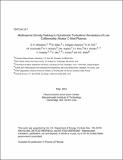Multispecies density peaking in gyrokinetic turbulence simulations of low collisionality Alcator C-Mod plasmas
Author(s)
Mikkelsen, D. R.; Bitter, M.; Delgado-Aparicio, L.; Hill, K. W.; Candy, J.; Waltz, R. E.; Howard, Nathaniel Thomas; Hughes Jr, Jerry; Reinke, Matthew Logan; Ma, Y.; Greenwald, Martin J.; Rice, John E.; Podpaly, Yuri; ... Show more Show less
DownloadMultispecies density.pdf (652.2Kb)
PUBLISHER_POLICY
Publisher Policy
Article is made available in accordance with the publisher's policy and may be subject to US copyright law. Please refer to the publisher's site for terms of use.
Terms of use
Metadata
Show full item recordAbstract
Peaked density profiles in low-collisionality AUG and JET H-mode plasmas are probably caused by a turbulently driven particle pinch, and Alcator C-Mod experiments confirmed that collisionality is a critical parameter. Density peaking in reactors could produce a number of important effects, some beneficial, such as enhanced fusion power and transport of fuel ions from the edge to the core, while others are undesirable, such as lower beta limits, reduced radiation from the plasma edge, and consequently higher divertor heat loads. Fundamental understanding of the pinch will enable planning to optimize these impacts. We show that density peaking is predicted by nonlinear gyrokinetic turbulence simulations based on measured profile data from low collisionality H-mode plasma in Alcator C-Mod. Multiple ion species are included to determine whether hydrogenic density peaking has an isotope dependence or is influenced by typical levels of low-Z impurities, and whether impurity density peaking depends on the species. We find that the deuterium density profile is slightly more peaked than that of hydrogen, and that experimentally relevant levels of boron have no appreciable effect on hydrogenic density peaking. The ratio of density at r/a = 0.44 to that at r/a = 0.74 is 1.2 for the majority D and minority H ions (and for electrons), and increases with impurity Z: 1.1 for helium, 1.15 for boron, 1.3 for neon, 1.4 for argon, and 1.5 for molybdenum. The ion temperature profile is varied to match better the predicted heat flux with the experimental transport analysis, but the resulting factor of two change in heat transport has only a weak effect on the predicted density peaking.
Date issued
2015-06Department
Massachusetts Institute of Technology. Department of Nuclear Science and Engineering; Massachusetts Institute of Technology. Plasma Science and Fusion CenterJournal
Physics of Plasmas
Publisher
American Institute of Physics (AIP)
Citation
Mikkelsen, D. R. et al. “Multispecies Density Peaking in Gyrokinetic Turbulence Simulations of Low Collisionality Alcator C-Mod Plasmas.” Physics of Plasmas 22, 6 (June 2015): 062301 © 2015 American Institute of Physics (AIP)
Version: Author's final manuscript
ISSN
1070-664X
1089-7674